Scientific name: Malus domestica
Common name: Apple Blossom
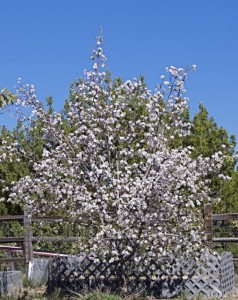
Winesap apple in full bloom (Janice Tucker)
Plant Family: Rose (Rosaceae)
By Janice Tucker with thanks to Barbara Goede for sharing her knowledge and notes, which contributed to this article.
The Rose family (Rosaceae) should be knighted as the plant family of beauty and bounty. It encompasses genera that produce gorgeous flowers and prolific fruit, many of which have been adapted to climates beyond their origins. The Apple (Malus) is arguably the Rose family’s most celebrated, edible, fruit-bearing plant. It certainly has to be among the oldest.
From fossils trapped in peat for millions of years, paleobotanists have reason to believe that a plum (Prunus) crossed with meadowsweet (Spiraea) to produce the first apple. This fruit was probably hard, misshapen, inedible and most likely poisonous (see source 1). Scientists believe that the apple known today as Malus domestica descended from Malus sieversii, a wild apple that originated and still grows in the Caucasus Mountains in the central Asian country of Kazakhstan. All of today’s domestic apple varieties and cultivars are part of the Malus domestica species. Throughout the years of its long existence, the apple has spread to many parts of the world. There are now more than 10,000 varieties of apples. The apples native to North America are crabapples, also of the Malus genus, and can cross-pollinate with the varieties of M. domestica. Bostonian Reverend William Blaxton first introduced the M. domestica to North America in 1625. Since then, the apple tree has spread to many regions within the United States. Several varieties and cultivars thrive in the Santa Fe climate.
The apple has been around long before man roamed the earth and much has been written about every aspect of its history, folklore, cultivation, usage, industry and so forth. There is too much information to cover everything in one article. Therefore, this article will mainly focus on the apple blossom from flower to fruit, and it will touch lightly on other apple topics. For planting apple tree information, read the apple tree article in the Santa Fe Gardening section.
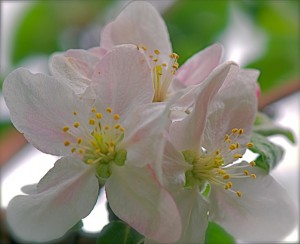
Apple blossoms golden del by Janice Tucker
From Flower to Fruit:
The apple tree is well organized and hard working. Its main purpose is to reproduce. After learning about the effort the tree expends to make an apple, you will develop a newfound appreciation of the next crisp, ripe apple you bite into.
The Malus domestica, including its many varieties and cultivars, are small, deciduous trees. The serrated leaves are alternate with downy undersides. While primarily planted for its fruit, an apple tree in full blossom is a beautiful sight to behold. When the tree emerges from dormancy in late winter or early spring, it has 2 primary jobs: To bear fruit, and to set the buds for the following year (see source 2).
Ever wonder why apples grow in clusters? They duplicate the blossom arrangement. The process of the apple blossom first begins when a bud appears along a branch or a longer shoot. In a few days clusters of four, rosy red buds surrounding a larger bud and leaves will emerge. The center bud, called the “king blossom”, will open first and will most likely become the largest apple of the cluster. The other buds open one at a time, which extends the pollination period. The fragrant, five-petaled flowers start out as pink and white, with the pink eventually fading out. When the blossoms first open, the stamens are heavily laden with moist, cream-colored pollen. The pollen dries rather quickly for easier distribution. This is a critical time in the flower-to-fruit procedure. If the temperature drops to 28 degrees or lower, the blooms will die. Damage can be determined if the base of the blossom is tan or brown. If the blossoms die, there will be no fruit to follow in the later weeks and months to come (see source 2).
Enjoy this photo slideshow of the flower-to-fruit process
With the exception of a few specially developed cultivars, apples cannot self-pollinate and must be cross-pollinated in order to reproduce. Honeybees primarily carry out apple blossom pollination, which is crucial to the flower-to-fruit process. Other insects such as bumblebees and butterflies also contribute. During the short pollination period, the seeds are formed in 5 carpels around the core of the apple. There are 2 whitish seeds in each carpel of a fully pollinated apple. As the apple continues to grow, the seeds turn a dark brown. If the apple is not fully pollinated, the
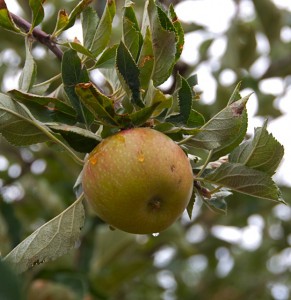 fruit will either be small or the tree will abort it so that its energy can be targeted to feeding the remaining apples. The seeds act as messengers, prompting the tree to feed the apple (see source 2). After the seeds are developed, the petals fall off. When the flesh and peel of the apple begin to form around the core, a tiny apple can be seen at the bottom of the fading stamens and calyx (see source 3).
fruit will either be small or the tree will abort it so that its energy can be targeted to feeding the remaining apples. The seeds act as messengers, prompting the tree to feed the apple (see source 2). After the seeds are developed, the petals fall off. When the flesh and peel of the apple begin to form around the core, a tiny apple can be seen at the bottom of the fading stamens and calyx (see source 3).
When the apples reach their ultimate size, cells will form across the stem, which stops the feeding. At this point the apple goes through a process of converting the flesh from lip-puckering sour to sweet or tart, depending on the variety. During this time, the tree is setting the bud for the next year’s fruit. This bud is visibly located near the stem of each apple and should not be removed when harvesting the fruit (see source 2). Most fully ripe apples are easily released from the branches, but use care when picking them in order to ensure that next year’s crop has a starting chance.
Make every effort to harvest the ripe apples before the birds descend upon the tree. While the tree normally produces enough for a home gardener and the birds, the birds are not that interested in sharing.
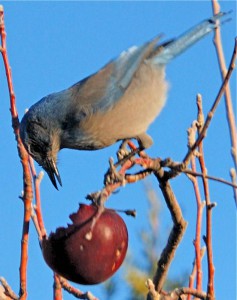
Scrub jay with apple (Janice Tucker)
Genetics and Propagation:
Apples love to mingle with each other, and after millions of years of crossbreeding without man’s influence, and thousands of years with man’s influence, its genetic makeup is extremely complex. Due to its genome, seeds from one apple will not resemble either parent in looks, taste, hardiness or size. To compare, the human genome is made up of about 20,000 to 25,000 genes. A recent study of a Golden Delicious Apple’s genome revealed it has a total of 57,000 genes. The offspring of humans usually do favor family members, at least in some way (see source 4). An apple planted from seed is basically untraceable when it comes to trying to track back to its parents.
John Chapman, best known as Johnny Appleseed, was legendary for raising conservation awareness and the importance of apple trees. He planted apple seeds in small nurseries throughout Pennsylvania, Ohio, Indiana and Illinois as well as in areas of what is now West Virginia. Since apples planted from seeds are usually sour, the apples from the trees planted by Chapman were primarily used for making cider. It takes about 7 to 10 years for an apple tree to grow from seed, and then it is uncertain what the result will be (see source 4). It is best to propagate apples by rootstock grafting in order to get a good-tasting apple variety that has been bred to thrive in a local environment.
More and Lore:
It is important to grow apple varieties suited to a specific climate. Check with local experts such as nurseries or tree farms for recommendations. The Santa Fe Botanical Garden has the following varieties in its Goede Family Orchard: Malus domestica ‘Ginger Gold’ and ‘Red Jonathan’. The orchard also has the following crabapple trees: Malus species ‘Radiant’ and ‘Indian Magic’.
Malus is Greek for apple or other tree fruits that have a fleshy exterior. In Latin, the word for apple is mālum, and the word for evil is mălum, with only the pronunciation symbols to differentiate the two words. It is often written malum, without a symbol over the “a”. In the Garden of Eden, Eve succumbed to temptation when she took a bite of the forbidden fruit from the Tree of Knowledge of Good and Evil. So it appears from that story, at least in Latin, that the word malum refers to either the evil or the apple….or both. Even though the fruit that tempted Eve has never been explicitly defined, the apple is usually the fruit mentioned the most when reciting that age-old story.
Greek mythology is filled with tales about the apple as a symbol of love and power including how the apple served as a catalyst that indirectly started the Trojan War. Uninvited to a wedding, Eris, the goddess of discord, threw a golden apple into the wedding party. Three goddesses, Hera, Athena and Aphrodite, all claimed the apple. Paris of Troy was given the job of choosing the recipient. All three goddesses tried to bribe Paris, but Aphrodite’s promise of giving him the most beautiful woman in the world, Helen of Sparta, was too irresistible. Aphrodite got the apple and Paris got Helen, who became known as Helen of Troy. Other apple myths abound in many countries, and a good number of them surround love. The Celts would decorate their bedchambers with apple blossoms in hopes of amorous nights. The folklore of apples is as plentiful as its rich history is long.
With the fervent hope that a late frost will not zap the blossoms, The Goede Family Orchard at the Santa Fe Botanical Garden on Museum Hill will soon be in bloom. Come be with us in apple blossom time.
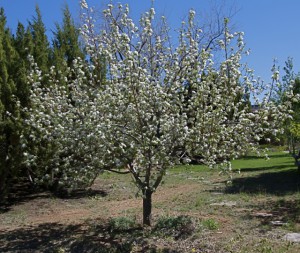
Jonathan apple tree in bloom (Janice Tucker)
Many thanks to Helen Woody for her valuable assistance in proofreading this and my previous plant of the month articles.
Sources:
1 Browning, Frank, Apples. New York, North Point Press 1998.
2 Goede, Barbara, Notes on Apple Blossom Process.
3 New England Apples, From Flower to Fruit. Hatfield, MA, www.newenglandapples.org.
4 Stewart, Amy, The Drunken Botanist. Chapel Hill, NC, Algonquin Books of Chapel Hill 2013.


